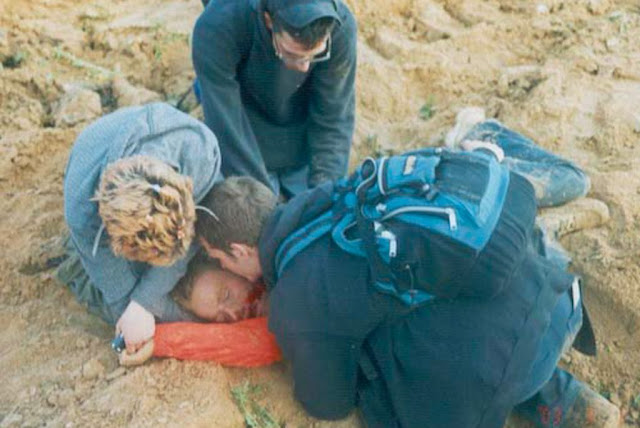It was 19 years ago
today on March 16, 2003 that Rachel Corrie, a 23 year old American volunteer with the International Solidarity Movement (ISM) was killed by an Israel Defense Forces (IDF) armored bulldozer as it attempted
to destroy the home of a Palestinian
doctor in the Rafah refugee camp in Gaza. The Palestinians
she died protecting are under even greater siege today with village
after village targeted for leveling to make way for new
settlements.
Eyewitness members of her ISM team say that
Corrie, wearing a bright orange jacket, was clearly visible to
the driver of the bulldozer before she fell off the mound of
earth it was pushing up and was crushed underneath the debris
and the tractor, which they said ran over her twice.
The IDF and
Israeli government have disputed that and claim that her death was an accident
in which the driver never saw her and the tractor never touched her. Despite promises, the official autopsy
report and the results of an official investigation have never been
released.
While Corrie’s
death stirred up international outrage, she was painted by right wing
Israeli media as, at best, a naïve dupe of terrorists and
more likely an active accomplice who deserved her fate.
Corrie was born
to middle class, politically liberal parents in Olympia Washington. She attended her hometown school, Evergreen State College, long known as hot
bed of activism. She wanted
to be an artist and writer.
She studied and was deeply moved by the writings on non-violence
by Gandhi and Martin Luther King. In her senior
year she devised an independent study program that included service
with the ISM in Gaza. She had already organized
a pen pal program between children in Rafah and Olympia youngsters.
She arrived in
Israel on January 22 and received two days of training in nonviolent
tactics at ISM headquarter on the West
Bank before being posted to Rafah.
It was an intense period of the Second Intifada with regular clashes between Israeli troops
and Palestinians.
Corrie spent
much of February at the Canada Well,
a water facility built by the Canadians that had been damaged by
the Israelis. She protected Palestinian
workers trying to do repair work.
She and they came under fire.
On February 15
she was present at a demonstration and was photographed holding a
burning paper replica of the U.S. flag. American right wing commentators would use
that photo later to claim she was a traitor to her country.
The IDF was in the
midst of a massive campaign to clear hundreds of homes and farms
from a new buffer zone by the Egyptian border. ISM observers routinely interceded by
placing themselves in front of bulldozers to prevent demolitions. Although there had been violent incidents
and camps where Corrie and others stayed were subject to harassing
arms fire at night, tractor drivers had always stopped before
harming the volunteers. Until the day
Corrie died.
In April two
other ISM volunteers were severally injured by the IDF. American Brian
Avery was shot in the face while protracting Palestinian medical
workers and Briton Thomas Hurndall
was shot in the head. He was declared
brain dead and finally died in 2004.
About the same time an experienced British news cameraman was
killed by IDF fire despite wearing clearly marked press identification.
There was speculation,
never proven, that Israeli authorities may have decided to target
Western witnesses to their activity in Gaza.
After Corie
died her family released letters and e-mails she had sent from
the Gaza. Articulate and moving
they were published posthumously as Let Me Stand Alone in 2008. The material was also used to create the play
My
Name is Rachel Corrie which opened in London in 2005 to good reviews and large audiences. An attempt to mount an American production
initially fell through with the British producers alleging
interference by pro-Israel forces.
It eventually opened off-Broadway. The play has been produced successfully
around the world, including, finally, in Israel.
Corrie’s life
and death have also been celebrated in a cantata and songs by
over 30 artists.
Meanwhile a counter
industry of anti-Corrie books and magazine articles
has also sprung up. As her death is commemorated
today by those who knew and loved her and by those who admired her, she
will be reviled, in often lurid terms on-line by commentators
in the U.S. and in Israel.
All of that—the
good and the hateful—will be dredged up today.
I, for one,
just try to remember a lively young woman who dared put her life on the line
for others.






No comments:
Post a Comment